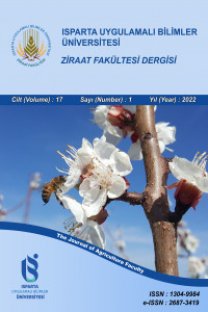Yağ Gülü (Rosa damascena Mill.) Damıtma Suyuna Katılan Tween-20’nin Taze ve Fermente Olmuş Çiçeklerin Gül Yağı Verimi ve Kalitesi Üzerine Etkisi
Yağ gülü, Rosa damascena Mill., fermentasyon, Tween-20, uçucu yağ kompozisyonu
Effect of Tween-20 Adding to Distillation Water on Rose Oil Yield and Quality in Fresh and Fermented flowers of Oil-bearing Rose (Rosa damascena Mill.)
Oil-bearing rose, Rosa damascena Mill., fermentation, Tween-20, essential oil composition,
___
- Anaç, O., 1984. Gas chromatographic analysis on Turkish rose oil, absolute and concrete. Perfumer & Flavorist. 9, 1-14.
- Antonelli, A., Fabbri, C., Giorgioni, M.E. and Bazzocchi, R. 1997. Characterisation of 24 old garden roses from their volatile compositions. J. Agric. Food Chem. 45, 4435.
- Aycı, F., Aydınlı, M., Bozdemir, Ö.A. ve Tutaş, M. 2005. Gas chromotographic investigation of rose concrete, absolute and solid residue. Falvour and Fragrance Journal. 20, 481-486.
- Başer, K.H., Kürkçüoğlu, M. ve Konur, O.Z. 1990. Türk gül yağının üretimi ve özellikleri. Anadolu Üniversitesi Tıbbi ve Aromatik Bitkiler Bülteni, Gül Özel Sayısı. 4, 13-15.
- Başer, K.H.C., 1992. Turkish rose oil. Perfumer & Flavorist. 17, 45-52.
- Baydar, H. 2006. Oil-bearing rose (Rosa damascena Mill.) cultivation and rose oil industry in Turkey. Euro Cosmetics. 14, 13-17.
- Baydar, H. ve Göktürk Baydar, N. 2005. The effects of harvest date, fermantation duration and Tween 20 treatment on essential oil content and composition of industrial oil rose (Rosa damascena Mill.). Industrial Crops and Products. 21, 251-255.
- Bayrak, A. and Akgül, A. 1994. Volatile oil composition of Turkish rose (Rosa damascena). J.Sci.Food Agric. 64, 441-448.
- Collin, H.A. 2003. Extraction and Industrial Processes. In: Encyclopedia of Rose Science. Elsevier Ltd. Academic Press. p. 726-735.
- David, F., De Clercq, C. and Sandra, P. 2006. GC/MS/MS analysis of β-damascenone in rose oil. Varian GC/MS App Note 52.
- Ercişli, S. 2005. Rose (Rosa spp.) germplasm resources of Turkey. Genetic Researches and Crop Evolution. 52, 787-795.
- Göktürk Baydar, N. ve Baydar, H. 2005. Turkish oil rose (Rosa damascena Mill.) products. 36th International Symposium on Essential Oils, 5-7 September 2005, Budapest-Hungary
- Gudin, S. 2000. Rose: Genetics and Breeding. Plant Breed. Rev. 17, 159-189.
- Haris, B. 2002. Methyl eugenol – The current bete noire of aromatherapy. International Journal of Aromatherapy. 12 (4), 193-201.
- Kovats, E. 1987. Composition of essential oils. part 7: Bulgarian oil of rose (Rosa damascena Mill.). J. Chromatography. 406,185-222.
- Kürkçüoğlu, M. ve Başer, H.C. 2003. Studies on Turkish rose concrete, absolute and hydrosol. Chemistry of Natural Compounds. 39 (5), 457-464.
- Lawrence, B.M. 1991. Progress in essantial oils: Rose oil and extracts. Perfumer & Flavorist. 16, 43-77.
- Stein, S.E. 1990. National Institute of Standards and Technology (NIST). Mass Spectral Database and Software, Version 3.02, USA.
- Weiss, E.A. 1997. Essential Oil Crops. CAB International, New York, USA.
- ISSN: 1304-9984
- Yayın Aralığı: Yılda 2 Sayı
- Başlangıç: 2006
- Yayıncı: Isparta Uygulamalı Bilimler Üniversitesi
Kemal DOĞAN, Mustafa GÖK, ALİ COŞKAN, Esin GÜVERCİN
HASAN BAYDAR, SABRİ ERBAŞ, Süleyman KINECİ, SONER KAZAZ
Esmer Sığırlarda Süt Verim Özelliklerine İlişkin Varyans Unsurlarının Tahmini Üzerine Bir Araştırma
L-Askorbik Asit ve Ekmekçilikteki İşlevleri
